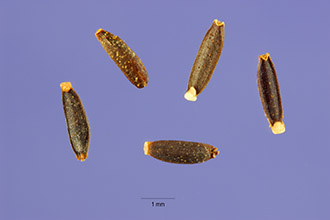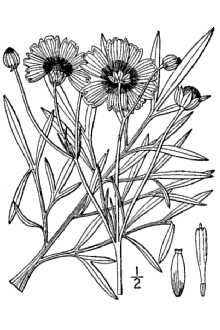Golden Tickseed
Scientific Name: Coreopsis tinctoria Nutt.

| General Information | |
|---|---|
| Usda Symbol | COTI3 |
| Group | Dicot |
| Life Cycle | AnnualBiennial, Perennial, |
| Growth Habits | Forb/herb |
| Native Locations | COTI3 |
Plant Guide
Use soil moisture sensors to measure the soil moisture of Golden Tickseed.
Fact Sheet
Alternate Names
Plains coreopsis, golden tickseed
Uses
This plant is used mainly for landscape beautification. It has potential for use in cultivated, garden situations, in naturalized prairie or meadow plantings, and along roadsides.
Status
Please consult the PLANTS Web site and your State Department of Natural Resources for this plant’s current status (e,g, threatened or endangered species, state noxious status, and wetland indicator values), Use soil moisture sensors to measure the soil moisture of Golden Tickseed.,
Description
Sunflower Family (Asteraceae). Calliopsis is an annual forb which usually germinates in late summer or fall and over-winters as a rosette (round, low growing group of leaves). This is a U.S. native. The stems begin growing upward and branching in spring, reaching a height of up to 4 feet. The opposite leaves are deeply divided, with the upper leaf segments being very narrow. The flowering heads are numerous, 1-2 inches in diameter, and are yellow with a red-brown center.
Adaptation
Calliopsis is adapted to many soil types. It grows best on a well-drained soil, but will not tolerate a very dry site. Natural stands are generally found on bottomland areas with ample moisture. It grows best in full sun, but will tolerate light shade. Calliopsis is distributed throughout the majority of the United States. For a current distribution map, please consult the Plant Profile page for this species on the PLANTS Website.
Establishment
A firm seedbed is required. Calliopsis germinates best on a clean tilled site that has been firmed with a roller or finishing harrow before planting. Seed can also be planted into a closely mowed, chemically-killed, or burned sod area with a light disking or harrowing that scratches the soil surface. A layer of plant residue on the soil surface can interfere with seed germination. Broadcast or shallowly drill 1-2 grams per 100 square feet (1-2 lb/acre). Seed should be placed close to the soil surface. Cultipacking after planting will ensure good seed to soil contact. Seed will germinate soon after planting and remain as a rosette throughout the winter. © Jim Stasz MD National Capital Park & Planning Commission @USDA NRCS PLANTS
Management
Plant growth and seed production are greatly improved by fertilization. Apply fertilizer according to soil test recommendations. If not available, a rate of 3.5-5.5 oz per 100 square feet (100-150 lb/acre) of 13-13-13 should be applied in the spring before flowering. Stands will reseed prolifically for several years, but will gradually decline without soil disturbance. Every two to three years, the site should be disked to control perennial weeds and promote calliopsis germination. If necessary, plants can be mowed in the spring before stem elongation begins. Stands that are not disked should be mowed in late summer, and a late fall mowing is also recommended.
Plant Traits
Growth Requirements
| Temperature, Minimum (°F) | 52 |
|---|---|
| Adapted to Coarse Textured Soils | No |
| Adapted to Fine Textured Soils | Yes |
| Adapted to Medium Textured Soils | Yes |
| Anaerobic Tolerance | Medium |
| CaCO3 Tolerance | Medium |
| Cold Stratification Required | No |
| Drought Tolerance | Low |
| Fertility Requirement | Medium |
| Fire Tolerance | Low |
| Frost Free Days, Minimum | 90 |
| Hedge Tolerance | None |
| Moisture Use | High |
| pH, Maximum | 7.8 |
| pH, Minimum | 5.2 |
| Precipitation, Maximum | 55 |
| Precipitation, Minimum | 20 |
| Root Depth, Minimum (inches) | 8 |
| Salinity Tolerance | None |
| Shade Tolerance | Intermediate |
Morphology/Physiology
| After Harvest Regrowth Rate | Slow |
|---|---|
| Toxicity | None |
| Shape and Orientation | Erect |
| Nitrogen Fixation | None |
| Resprout Ability | No |
| Active Growth Period | Spring and Summer |
| Bloat | None |
| C:N Ratio | Medium |
| Coppice Potential | No |
| Fall Conspicuous | No |
| Fire Resistant | No |
| Flower Color | Yellow |
| Flower Conspicuous | Yes |
| Foliage Color | Green |
| Foliage Porosity Summer | Porous |
| Foliage Texture | Medium |
| Low Growing Grass | No |
| Lifespan | Short |
| Leaf Retention | No |
| Known Allelopath | No |
| Height, Mature (feet) | 3.0 |
| Growth Rate | Rapid |
| Growth Form | Single Crown |
| Fruit/Seed Conspicuous | No |
| Fruit/Seed Color | Brown |
| Foliage Porosity Winter | Porous |
Reproduction
| Vegetative Spread Rate | None |
|---|---|
| Small Grain | No |
| Seedling Vigor | High |
| Fruit/Seed Period Begin | Summer |
| Seed Spread Rate | Moderate |
| Seed per Pound | 3222222 |
| Propagated by Tubers | No |
| Propagated by Sprigs | No |
| Propagated by Sod | No |
| Propagated by Seed | Yes |
| Propagated by Corm | No |
| Propagated by Container | No |
| Propagated by Bulb | No |
| Propagated by Bare Root | No |
| Fruit/Seed Persistence | No |
| Fruit/Seed Period End | Summer |
| Fruit/Seed Abundance | High |
| Commercial Availability | Routinely Available |
| Bloom Period | Late Spring |
| Propagated by Cuttings | No |
Suitability/Use
| Veneer Product | No |
|---|---|
| Pulpwood Product | No |
| Post Product | No |
| Palatable Human | No |
| Nursery Stock Product | Yes |
| Naval Store Product | No |
| Lumber Product | No |
| Fodder Product | No |
| Christmas Tree Product | No |
| Berry/Nut/Seed Product | No |

